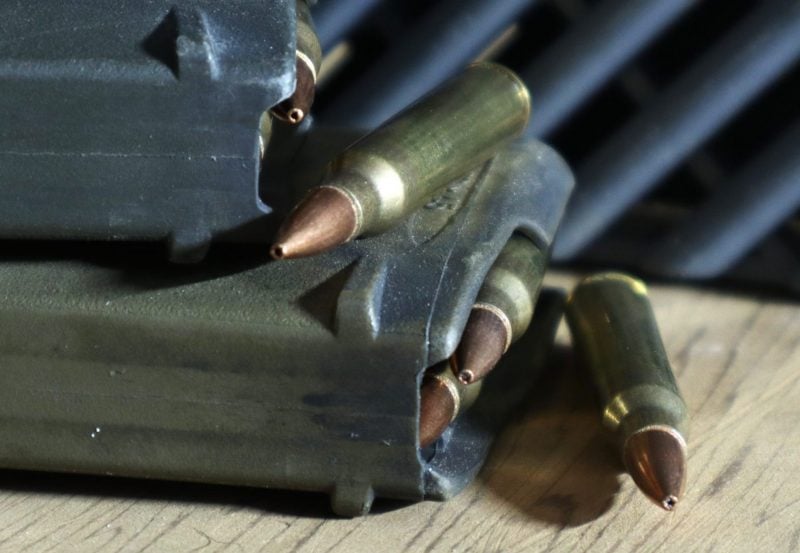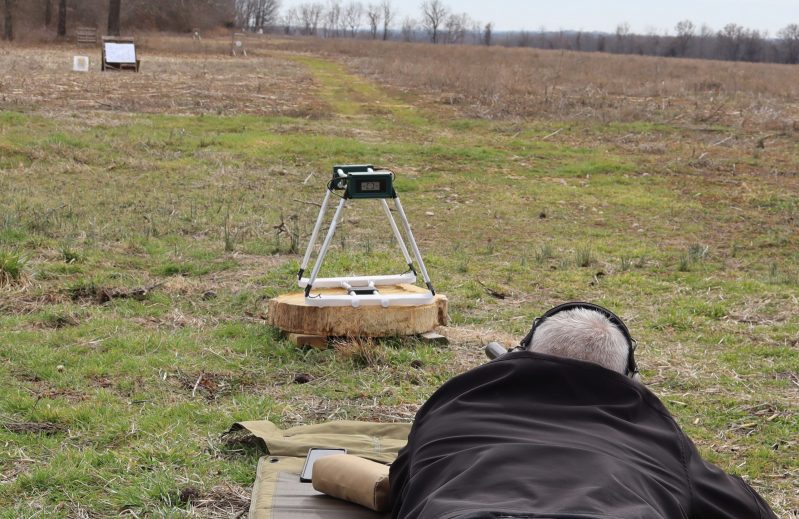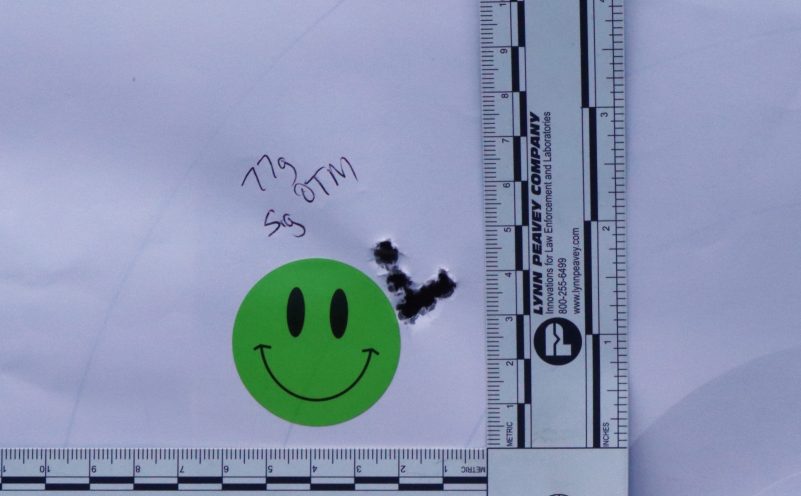When Stoner’s original AR-15 began production, it was equipped with a 1:14 twist rate. While this was adequate for stabilizing 55-grain bullets of the day, it is far too slow for most of today’s 77-grain cartridges. The current standard for most AR-15 twist rates is 1:7. For those not in the know, a 1:7 twist rate means the barrel’s rifling turns the bullet one full revolution every seven inches.
As barrel twist rates evolved over the last 50 years, ammunition manufacturers did as well. The once standard 55-grain FMJ target round has slowly been replaced with 62- and 64-grain loads. Hunting and defensive ammunition followed accordingly, and with the AR’s massive popularity, the .223 and 5.56 NATO varieties have expanded greatly.

While 77-grain bullets are considered the gold standard for maximizing long-range accuracy out of the AR-15 platform, will all 77-grain factory loadings perform the same? While not an exhaustive list, a recent range day with some fellow shooters helped us better understand the current 77-grain playing field for the venerable .223 cartridge.
77-Grain Brands Tested
The vast majority of 77-grain .223 ammunition features an “OTM” design. OTM refers to “Open Tip Match”. While the cartridge appears to be a traditional hollow point, the bullet’s open tip does more to enhance the bullet’s flight than aid with expansion. For testing, we selected three common 77-grain offerings and a bonus 75-grain loading.
Sig Marksman
Sig has come on strong in recent years with a full lineup of optics and ammunition to complement its firearms. The Sig Marksman line of ammunition includes their 77-grain OTM .223 Remington cartridge. The Marksman line comprises match-grade ammunition for shooters looking to maximize their precision out of the AR platform.
Federal Gold Medal Match
Federal Gold Medal Match shouldn’t require much of an introduction. I’ve used their .308 Winchester line of Gold Medal Match in 168- and 175-grain loadings for years with consistently impressive results. For testing, we used Federal’s 77-grain BTHP Sierra MatchKing load, hoping to see their reputation remain unblemished.
Black Hills
Black Hills Ammunition is the brainchild of the legendary MK262 Mod1-C cartridge. This cartridge has been used to great effect overseas and largely set the standard for combat accuracy out of the AR-15. For testing, it only seemed sensical to use the MK262, a 77-grain OTM. Black Hills tests each lot of ammunition with 10 strings of 10-shot groups. To pass, the groups must all measure under two inches at 300 yards.
Hornady TAP
Hornady’s TAP (Tactical Application Police) line of cartridges has long been a staple of law enforcement ammunition options. For testing, we included their 75-grain BTHP TAP Precision cartridge. This load advertises better penetration and more reliable expansion than lighter bullet weights while offering precision rifle accuracy. This cartridge maintains a nice balance between law enforcement needs requiring accuracy, penetration, and rapid expansion on target.
Testing Parameters
The four cartridges were tested on a relatively nice Missouri winter morning. With a somewhat strong crosswind, we opted to measure accuracy at 50 yards. While these cartridges are capable of far greater distances, 50 yards was enough to compare each cartridge’s accuracy and see if one distinguished itself from any others.
Not all rifles shoot the same. For example, you can take two Remington 700 rifles, one built immediately after the other, and they won’t necessarily shoot the same ammunition well. While one rifle may like Federal, another may prefer Winchester or Remington. With our testing, we opted to use several rifles with the same configuration. All shots were fired from Sig AR-style rifles equipped with LPVOs (Low Powered Variable Optic) and a 1:7 twist 10.5-inch barrel. To reduce any inconsistency from variances in shooting skill, we had the same person shoot each of the groups from the three rifles used for the test.

A Caldwell Chronograph provided us with muzzle velocity data across each string of fire while we obtained five-shot groups from each factory load out of each rifle. As a result, we obtained a relatively nice data spread to compare each load.
77-Grain Data
The final results were interesting, to say the least. While virtually all of the tested ammunition produced acceptable groups, we quickly identified one rifle wasn’t performing to expectations. Where the other two rifles produced ragged holes relatively easily, the other grouped very poorly with groups in excess of two inches or more at 50 yards. After some troubleshooting, we remained puzzled at the poor performance but isolated the issue to possibly a barrel defect or damage.
| Ammunition | Average by rifle | Total Average | Standard Deviation (STDEV) by rifle | Total STDEV | ||||
| Sig Marksman | 2087 | 2093 | 2067 | 2082 | 13.8 | 9.4 | 17.0 | 17.5 |
| Federal Gold Medal | 2150 | 2133 | 2143 | 2142 | 13.7 | 17.3 | 14.2 | 16.7 |
| Black Hills MK262 | 2358 | 2337 | 2342 | 2346 | 14.4 | 5.1 | 12.5 | 14.3 |
| Hornady TAP | 2250 | 2247 | 2242 | 2246 | 11.6 | 12.5 | 19.3 | 15.2 |
In past experiences, these rifles shot well but they didn’t perform to this level. The 77-grain (and one 75-grain) loads tested met or exceeded our expectations. While the results are subject to interpretation, it was enough to make some determinations about each load’s performance, accuracy, and general capability. While terminal performance is a subject worth delving into at a later date, the results definitely helped us develop some conclusions about each load’s external ballistics.
77-Grain Performance
The primary theme amongst all of the loads tested is they were “precision” cartridges. Accordingly, we should expect repeatable performance. Precision ammunition should also have tighter quality control and consistency. This is especially relevant with measured muzzle velocity.
Muzzle Velocity
The standard deviation in a string of fire is effectively the variance in velocity from the shot string’s average. A larger standard deviation indicates inconsistent ammunition. Variances in powder charge, case, primer ignition, bullet seating depth, and many other factors can produce inconsistent velocities.
The tested cartridges all had a 17 feet per second (fps) or less variation, which translated to less than 1% variation in muzzle velocity across all cartridges. Unsurprisingly, Black Hills MK262 produced the fastest average velocity at 2,346 fps along with the smallest standard deviation (14.3 fps). Even the worst performer, Sig Marksman, was no slouch, with a 17.5 fps standard deviation. However, the Sig produced the lowest average velocity at 2,082 fps.
Accuracy
Any time I discuss accuracy in a review or comparison, I do so cautiously. What shot well in my rifle may not perform to the same level with your rifle. This principle cuts both ways and finding an accurate load for a personal rifle is an individualized process of finding what your gun likes or doesn’t like. Regardless, since we had three rifles of the same make, model, and barrel length readily available, it offered an opportunity to draw some conclusions about each load’s accuracy.

Overall, the Sig Marksman took a narrow lead in the accuracy department, with Hornady TAP not far behind. In extrapolating from the data some, I think Sig’s lower velocity contributed to producing better groups. However, a tight group at 50 yards won’t necessarily translate to a tight group at 300 yards. The Sig’s slow velocity increases the trajectory’s arc, and as the bullet slows, the decreased velocity can negatively affect the round’s stability. This line of reasoning makes sense, as the Black Hills didn’t exactly produce the tightest group at 50 yards. However, this ammunition is renowned for producing impressive groups in excess of 500 yards. The faster velocity helps the bullet retain stability and shoot flatter at greater distances. As a result, the MK262 and Hornady TAP, with their higher velocities, will most likely maintain accuracy at greater distances than their slower counterparts.
Final Points
While a more exhaustive test can certainly be done, time constraints cut short our range day. However, the data gleaned from testing these cartridges provided some insight into the role of heavier bullets with the modern AR-15. With a 1:7 barrel twist rate now the standard to be met for a quality AR-15, I foresee manufacturers producing a larger array of heavier loads for the 5.56 NATO and .223 Remington cartridges. While the four cartridges we tested all performed well, there are plenty more options available on the market today. Currently, GunMagWarehouse offers nine options for 75- and 77-grain cartridges in .223 Remington, along with three additional 75-grain loadings in 5.56 NATO. If you have an AR with a 1:7 twist rate sitting at home and you haven’t done so already, grab a few boxes and see how these heavier cartridges perform. You might be pleasantly surprised at the accuracy you can squeeze out of your platform.


